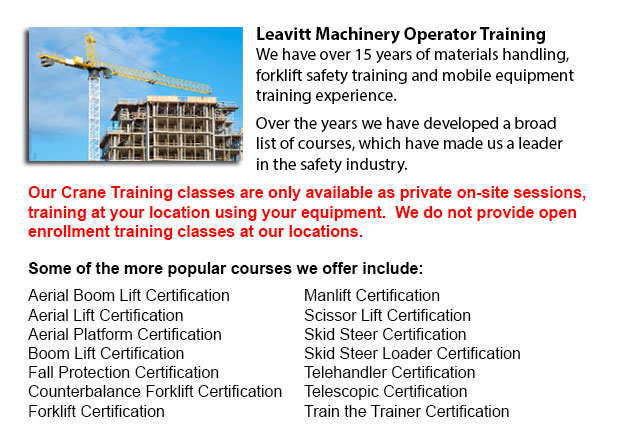
Overhead Crane Safety Training BC - The overhead crane safety training program is intended to equip the operators with the right skills and knowledge in the areas of: crane safety measures, accident avoidance, materials handling, and stock and equipment protection. Each of the trainees would get to learn about numerous kinds of overhead cranes, their capabilities and their uses in various environments. For operators who are licensed and trained, the shift in liability moves from the company to the operator. Thus, the course emphasizes individual operator duties.
Overhead crane safety training instructs operators in the correct ways for doing checks. Two types of pre-shift check are the walk-around inspection and the in-depth inspection. These are vital every day routines that should be logged. Properly recorded pre-shift checks help to protect the company from liability in the event of an accident. Pre-shift inspections likewise prevent damage, expensive repairs and accidents. Operators learn how to designate a particular person to handle inspections, how to report problems, and how to maintain the log book.
Checks must be done often and documented correctly. The following must inspected while watching for common problems: increase in the throat opening, hooks for cracks, hoist ropes for corrosion, degree of twist, worn wires, loss of diameter, bird caging and kinks, broken wires, chemical and heat damage; chains for gouges and nicks, corrosion and cracks, twists, excessive wear, distortion, stretching, pits, damage caused by extreme heat.
Operators learn correct rigging methods in this program. Rigging involves understanding the manufacturer's data plate, determining the weight of materials to be lifted, selecting the gear, and utilizing safe practices to secure the load. The course cover in detail the following: safe working loads, and the capacities of ropes, chains, slings, hooks and shackles.
It is essential to understand who may operate the cranes at your facility, physical requirements of the job, and operator qualifications needed for specialized tasks and permits. Safety is a top priority when utilizing in the vicinity of pedestrian traffic.
Safe crane utilization involves responsibilities such as checking for hydraulic leaks, undertaking visual inspections, testing the controls, checking the safety guards, examining the hoist rope and hook, braking mechanisms and limit switches. Right reporting methods are important. These subject matters are all included in depth in the course.
The course likewise includes the correct lifting and moving procedures with cranes and hoists. Operators will likewise learn correct hand signals. Training involves how to raise the load, attach the load, abort a lift, set the load and unhook the slings.
Moving the load includes a few steps: starting and stopping procedures, controlling and guiding the load, observing working conditions and working with signals. Operators should know how to proceed in the event of a power failure. The course includes methods for removing the slings and lowering the load, parking the crane, storage equipment, and securing an outdoor and indoor crane.
-
Zoom Boom Ticket BC
Zoom Boom Ticket BC - Zoom Boom Training focuses on correctly training prospective operators on variable reach forklifts. The training objectives include gaining the understanding of the equipments physics and to be able to define the job of the oper... More -
Scissor Lift Training BC
Scissor Lift Training BC - When operating a scissor lift, they should be used competently in order to protect the wellbeing of the other personnel in the workplace and to protect the safety of the equipment. Operators who are skilled are trained to d... More -
Wheel and Track Loader Training in BC
Lift trucks are obtainable in several load capacities and several models. Nearly all forklifts in a regular warehouse surroundings have load capacities between one to five tons. Bigger scale models are used for heavier loads, like loading shipping co... More -
Zoom Boom Training BC
Zoom Boom Training BC - Zoom Boom Training focuses on properly training prospective operators on variable reach forklifts. The training goals consist of gaining the knowledge of the machine's physics and to define the responsibilities of the operator... More -
Heavy Equipment Operator Certification BC
Heavy Equipment Operator Certification BC - The heavy equipment operator is a person who manipulates the controls and drives various types of huge machinery. Heavy machinery is most commonly used on construction sites to deliver supplies to the site... More -
Crane Ticket BC
Crane Ticket BC - New cranes can either be complex or simple, based on the nature of the application they are able to do. For example, mobile cranes are rather simple models. A steel truss and even a telescopic boom mounts its movable platform. A sys... More -
Telehandler Training in BC
Telescopic handlers normally known as telehandlers for short, are a very popular piece of heavy construction machinery. They are commonly utilized in the construction and agricultural industries. These equipments have maximum reaching capacity and ar... More -
Wheel Loader Training BC
Wheel Loader Training BC - Normally, the various types of heavy equipment training are divided into 2 categories of equipment: those which have rubber tires and tracked vehicles. Tracked vehicles comprise items like excavators, cranes, and bulldozers... More

Forklift Training BC
TOLL FREE: 1-888-254-6157
forkliftcertificationbritishcolumbia.com
Email Us
About Us


